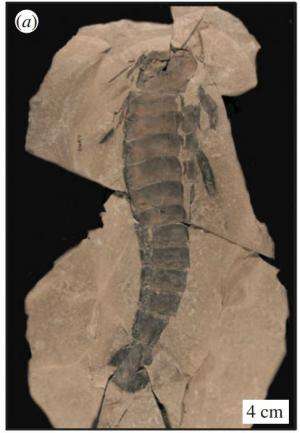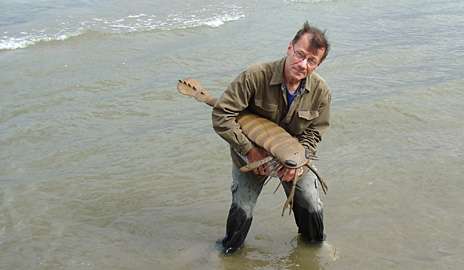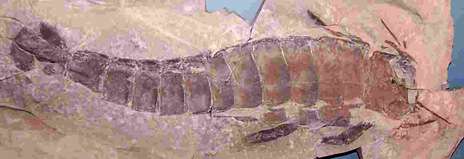July 9, 2014 report
Closer look at ancient giant sea scorpion suggests poor vision limited its hunting abilities

(Phys.org) —A team of researchers from Yale University and University College Cork in Ireland has concluded that the ancient giant sea scorpion (Acutiramus cummingsi) wasn't quite as terrifying as initial reports had suggested. In their paper published in the journal Biology Letters, the team describes how they conducted an analysis of the ancient sea creature's vision abilities and found them to be lacking—they suggest A. cummingsi's eyesight was so poor that the arthropod most likely survived by eating plants or slow moving soft-shelled prey.
When scientists first learned of A. cummingsi, (which existed over 400 million years ago) via fossil finds, they imagined a creature capable of chasing down cephalopods of all sizes and crushing their hard-shells. More recently, another team found that the giant pincers (with teeth on them no less) sported by the creature didn't have enough muscle behind them to tear apart hard shells to get inside. Now, in this new study, it appears the largest known arthropod ever to have lived on this planet, had vision so poor it wouldn't have been able to chase and catch such prey anyway.
To gain a better understanding of just how well the creatures were able to see, the researchers studied several fossil specimens, some with eye lenses that were big enough to study unaided by microscopes—smaller specimens were examined using an electron microscope. The researchers then made estimates of lens angle and eye size and compared what they'd found with the eye parts of modern creatures. In so doing, they came to the conclusion that A. cummingsi, wasn't able to see very well at all—so poor was their vision that they wouldn't have been able to catch anything moving very fast, which would have relegated the giant to the bottom of sea, feeding on plants and soft-bodied (or already dead) creatures, in the dark.

The researchers note that their work isn't the definitive last word on the hunting abilities of the giant sea scorpion, however, because a lot of what happens with vision, happens in the brain, which of course can't be studied, because there are no associated brain fossils to examine.

More information: What big eyes you have: the ecological role of giant pterygotid eurypterids, Published 9 July 2014 DOI: 10.1098/rsbl.2014.0412
Abstract
Eurypterids are a group of extinct chelicerates that ranged for over 200 Myr from the Ordovician to the Permian. Gigantism is common in the group; about 50% of families include taxa over 0.8 m in length. Among these were the pterygotids (Pterygotidae), which reached lengths of over 2 m and were the largest arthropods that ever lived. They have been interpreted as highly mobile visual predators on the basis of their large size, enlarged, robust chelicerae and forward-facing compound eyes. Here, we test this interpretation by reconstructing the visual capability of Acutiramus cummingsi (Pterygotidae) and comparing it with that of the smaller Eurypterus sp. (Eurypteridae), which lacked enlarged chelicerae, and other arthropods of similar geologic age. In A. cummingsi, there is no area of lenses differentiated to provide increased visual acuity, and the interommatidial angles (IOA) do not fall within the range of high-level modern arthropod predators. Our results show that the visual acuity of A. cummingsi is poor compared with that of co-occurring Eurypterus sp. The ecological role of pterygotids may have been as predators on thin-shelled and soft-bodied prey, perhaps in low-light conditions or at night.
Journal information: Biology Letters
© 2014 Phys.org




















